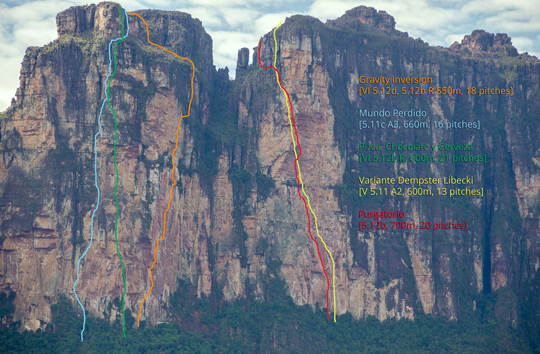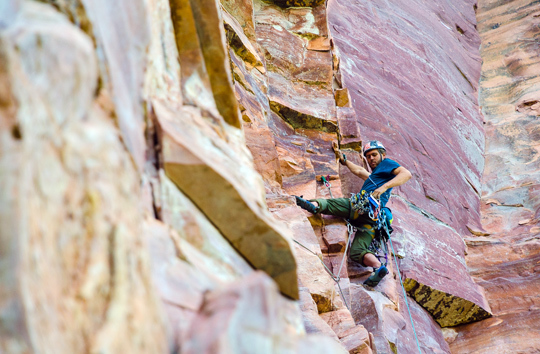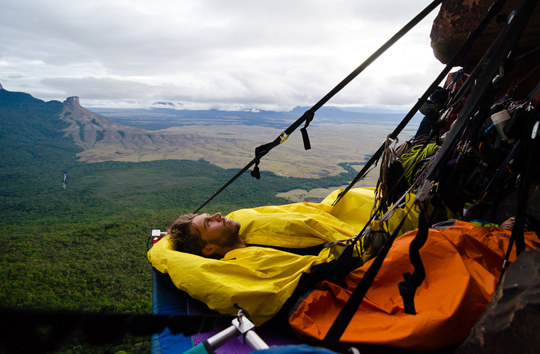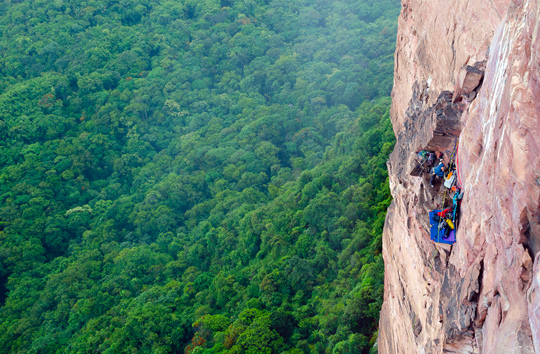
Acopan Tepui, Gran Sabana, Venezuela
As the sun’s first glow brought me out of sleep, I found my limbs stiffened around a pile of haulbags. Harsh rays illuminated the figure towering above–Simon Bolivar’s likeness standing guard over our weary team of four, crumpled around our small mountain of gear. Events of the past three days trickled back into my memory: bus breakdowns, motorcycle gangs, cheese-filled arepas and Venezuelan military searches. A twisted chain of events had brought us here, to Santa Elena, and delivered us into the hands of the town police, who graciously offered their station lawn for the night. Exhaustion from days of travel faded for a moment. We considered what else lay in wait between us and the wall.
In January 2014, Arizona climbers Eric Deschamps, Luis Cisneros, Blake McCord and I established Gravity Inversion (VI 5.12d [5.12b R]) on Acopan Tepui’s north face. Acopan was first climbed in 2002 and, in the decade following, around 20 routes have been established on many distinct walls of the miles-wide formation.
After six days of travel by plane, bus and police car, our bush flight landed in the small village of Yunek. From there, we hoped to climb the north face of Acopan, host to the 2003 route Pizza, Chocolate y Cerveza (VI 5.12b R, 600m)–established by Anne Arran, John Arran and Alfredo Rangel–and Purgatory (VI 5.12, 700m), a Stefan Glowacz, Holger Huber, Kurt Albert and Ivan Calderon route put up in 2007. We imagined our line up the steep, red and unclimbed pillar in between.


Clean rock extended down nearly to the base of the wall, allowing us to begin our route with only 10 meters of jungle climbing on the first pitch. (Other visitors to Acopan Tepui have not been so lucky.) Four pitches of discontinuous vertical cracks and corners, linked by horizontals, led to an eight-meter roof system split by a thin, parallel crack. This pitch was freed at 5.12d and is the crux of the route. We established our first camp 30 meters above the crux roof on a small ledge.
Above, varied sandstone features provided difficult climbing with sparse but adequate protection. The path of least resistance from Camp 1 trends right through square-cut and sloping edges with gear in horizontals, well-defined cracks in smooth corners and wind-sculpted horns, jugs and huecos in solid dark red rock. A prominent red dihedral gained our passage through a band of vegetation, and we made Camp 2 beneath another major roof system, the Eyebrow.

Making progress from Camp 2 proved our route-finding crux, with no cracks or corners leading upward and soft, exfoliating rock under the Eyebrow that offered no protection. After allowing us easy passage at the base, Acopan now seemed to be extracting its toll. We were deflected right, climbing textured edges through pink, green and grey rock for 130 meters, but deteriorating rock, sealed-up cracks and wet vegetation kept us from moving in our desired direction: up.
We spent several days at this apparent impasse, and finally discovered a heavily vegetated traverse leading to a ledge. Thirty more meters of thick jungle above the ledge led to an offwidth and chimney system. After kick-stepping in moss and hacking through vines, we were rewarded with clean hand and finger cracks in high quality rock on the last pitch. A hundred meters of third- and fourth-class climbing over boulders and through deep chimneys and caves then led to the incredible summit plateau.

Over 11 days of on Acopan, we climbed three pitches of 5.10, nine pitches of 5.11 and six pitches of 5.12, freeing every pitch as we moved up. We placed bolts only at anchors for hauling and rappelling; one pin was placed for protection on Pitch 12. Although the wall is overhanging, we were able to rappel our route, placing directionals and down-aiding the steepest sections.
